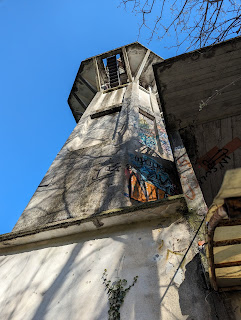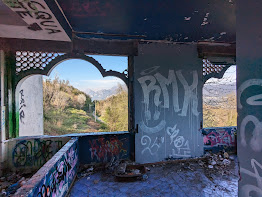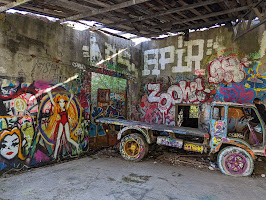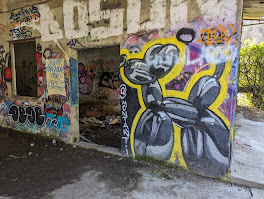Images of Consonno, Italy. The minaret is the most characteristic part of this abandoned town.
Overview
We finally had a chance to see the little-known (to Italians that is) town of Consonno, Italy. We drove over from Bergamo with a friend, whose partner pooh-poohed the place as boring and for druggies. Sour grapes...we had a interesting visit.
Consonno located at 640m above sea level in a forest is just a few miles west (and uphill) from the town of Olginate on Lago di Garlate. Lago di Garlate is like the left foot of Lago di Como. It’s a part of Lombardy that is off the beaten track.
Great, but why is Consonno famous? Why is it a ghost city? The Count Mario Bagno – a entrepreneur from Milan - purchased the town in the early 1960s and bulldozed most of the small agricultural hamlet to create a mini “Las Vegas” complete with hotel, dance hall, shops, restaurant, and fantastical mishmash of architecture including pagodas and minarets. By the late 1960s and early 1970s, the site was in full swing.
Mother Nature however had other plans for the mountainous site: landslides. The final landslide put a kibosh on the mini Las Vegas in 1976. Though, the attraction had already been in decline.
Today, the town is private and owned by the heirs of the Count. It has been up for sale for some time. We heard the price was about 12 million. Got some loose change hanging around?
Except for opening days and other special events, the road leading to Consonno is usually barred and you leave your car at the farthest point you can get to and walk the rest of the way on foot on the road or on one of the many trails. About 2km. Today, we were lucky because the group Sbanda Brianza Longboarding was running a clean-up day (April 6) and the gates were open so we drove all the way up.
Ex novo
There are also planned city examples that were failures: Lavasa (India), Ordos (China), PlanIT Valley (Portugal). Maybe it depends on the ideas and motives behind the ex-novo construction and a bit of luck.
Visiting Consonno made us think of many things touching on other utopian projects and ex novo cities, including:
- Fordlândia, a district in the city of Aveiro, in the Brazilian state of Pará established by American industrialist Henry Ford in the Amazon Rainforest in 1928. The town was intended to be a prefabricated industrial town inhabited by 10,000 people to secure a source of cultivated rubber for the automobile manufacturing operations of the Ford Motor Company in the United States. The effort failed and the city was abandoned in 1934. (Check out the great album of the same name by Jóhann Jóhannsson.)
- The California Forever project in Solano County, California. We’ve learned about this project recently and are skeptical. Yes, the ideas and ideals and renderings behind this effort are great, but there is something off-putting about it. Can you really construct a community ex-novo? Communities tend to grow organically – for better or worse – from a nucleus or seed. Okay, Consonno’s aims right from the start were not as lofty as California Forever, but still, lots of money arriving to say we are going to make life wonderful should give one pause.
- The graffiti and aesthetic of Consonno made us think of Slab City in Southern California. (See Slab City Tank Farm Murals – Wheel of Kama.)
- Italy – at least in the north – has what we would say is a lot of abandoned industrial architecture. In our backyard of Val Seriana, an industrial center in Italy, you can’t help but notice the abandoned structures along the Serio river, once an important source of energy.
- In 2016, we went to see Crespi D’Adda. (See Two Day Trips from Bergamo: Sirmione and Crespi d’Adda.) Crespi d’Adda is a company town along the river Adda, built by the “enlightened” industrialist Cristoforo Benigno Crespi in the late 19th century. The factory produced textiles and has been a UNESCO World Heritage Site since 1995. The idea behind Crespi d’Adda was to provide workers with more than just a place to work: the town included housing for workers as well as a school, a church, and other social services. A cradle to grave solution so to speak. The utopian ideals behind the town endured for a surprisingly long time, running from the late 1800s until the factory closed in 2003.
- In 2017, we visited the city of Palmanova, Italy. (See Walking Around Palmanova, the Fortress City in Friuli-Venezia Giulia.) We were always intrigued by the star-shaped design of the city. It was designed as a fort-city by the Venetians in the late 1500s. The design followed Renaissance utopian ideas, with interesting symmetry and a practical layout. Yet, walking around and inside the city felt awkward and like we were in a de Chirico painting - the ones with the empty and foreboding public spaces.
- In 2022, we visited the Museo Hendrik Christian Andersen in Rome. Besides walking among the erotic, oversized statues we also learned that those very same works were created with the idea of designing a perfect "World City," filled with art. This perfect city would motivate humanity to achieve a near-Utopian state. His urban planning philosophy is evident in his 1913 A World Center of Communication. The sketches of the city looked so perfect and so boring at the same time. The city was never built.
The future
We were really impressed with the Sbanda Brianza Longboarding and their work to bring this town back to life and give it new meaning.... organically, and step-by-step. And, it's cool that longboarding is a huge thing there on the road that the Count had originally built.
In Italian, Consonno has been called the Città Fantasma, Città dei Balocchi, and the Las Vegas di Brianza. Maybe there is a future name – a better name – for this area with the help of the Sbanda group to grow something more community-based and more organic.
As you drive up to Consonno, there are signs from its heyday with overly festive, almost coercive messages that basically say you will be happy here! Here they are in Italian with translations:
As you drive up to Consonno, there are signs from its heyday with overly festive, almost coercive messages that basically say you will be happy here! Here they are in Italian with translations:
- “A Consonno è sempre festa.” (In Consonno, it’s always a party.)
- “Consonno è il paese più piccolo ma il più bello del mondo.” (Consonno: the smallest but most beautiful town in the world.)
- “A Consonno tutto è meraviglioso.” (Everything is wonderful in Consonno.)
- “Chi vive a Consonno campa di più.” (Those who live in Consonno live longer.)
Photos
The church that was an original building and the minaret constructed in the 1960s.


Consonno is private property except for one part run by the Sbanda.




Consonno is private property except for one part run by the Sbanda.


Signs in Consonno, Italy. Left: Chi vive a Consonno campa di più. Right: Consonno è il paese più piccolo ma il più bello del mondo.













No comments:
Post a Comment
All comments are moderated. If your comment doesn't appear right away, it was likely accepted. Check back in a day if you asked a question.